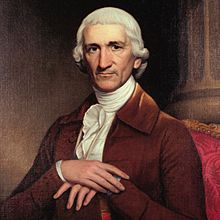Charles Thomson (writer)
Charles Thomson (born November 29, 1729 in Maghera , County Derry , Ireland , † August 16, 1824 in Lower Merion , Montgomery , Pennsylvania ) was an American writer and politician of Irish origin .
Life
Thomson emigrated from Ireland to North America with his father and three brothers. Shortly before arriving in New Castle , Delaware , his father died. Through a relative who had lived in the country for some time, he met Dr. Francis Allison , who in 1743 enabled him to attend the New London Academy in nearby Chester County , Pennsylvania .
Thomson served from 1774 to 1789 for the entire period of its existence as secretary of the revolutionary and later regularly state-sponsoring Continental Congress or Confederate Congress, until it was replaced by the 1st Congress and a central federal government after the ratification of the second constitution of the United States . His meticulous records of the debates and decisions of the Congress created an overview for posterity of the institution, which throughout its existence has been characterized by frequent staff changes and an average residence time of two years. In addition to his writing activities, he played an important role in foreign policy, especially from a foreign point of view, by coordinating diplomatic and domestic correspondence and was considered, as in Vol.CI (101), 1977 of the Pennsylvania Magazine of History and Biography by Fred S. Rolater named as the "Prime Minister" of the United States.
As secretary, Thomson also came under fire: James Searle , an MP and friend of John Adams , saw himself misquoted in the minutes of the meeting and attacked Thomson on the premises of Congress with his walking stick. In the course of the tussle, the two men inflicted a cut on the face. Brawls were not uncommon in Congress and were often sparked by disputes over Thomson's records.
Thomson also goes into the history books as one of the designers of the Seal of the United States ( Great Seal of the United States ) in 1782, after in previous years over a longer period three different commissions were consistently failed it.
In his later life he worked, among other things, as a merchant in Philadelphia and as a politician , where he distinguished himself by actively participating in the resistance struggle against the British. After the dissolution of the Confederate Congress, he no longer played a role in the top politics of the new nation, but maintained contact with the leading personalities. In a letter to John Adams in 1822 , Thomas Jefferson described how tragic he felt Thomson's senility in old age. Charles Thomson died at the age of nearly 95.
Works
- An inquiry into the causes of the alienation of the Delaware and Shawaneese Indians (1759)
- A synopsis of the four evangelists (1815)
Web links
- Charles Thomson in the database of Find a Grave (English)
literature
- Harley, Lewis Reifsneider. The Life of Charles Thomson (1900). Repr.
Individual evidence
- ↑ "... My Zeal for Liberty" at ushistory.org, accessed September 27, 2017
| personal data | |
|---|---|
| SURNAME | Thomson, Charles |
| BRIEF DESCRIPTION | American writer and politician of Irish descent |
| DATE OF BIRTH | November 29, 1729 |
| PLACE OF BIRTH | Maghera , Ireland |
| DATE OF DEATH | August 16, 1824 |
| Place of death | Lower Merion , Pennsylvania |

